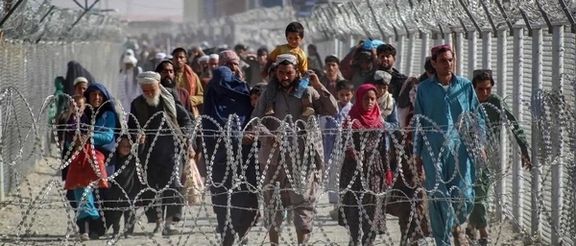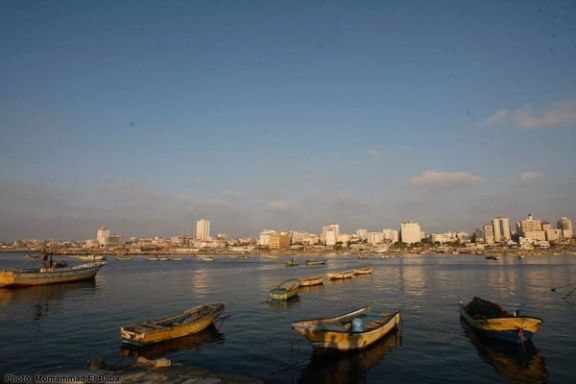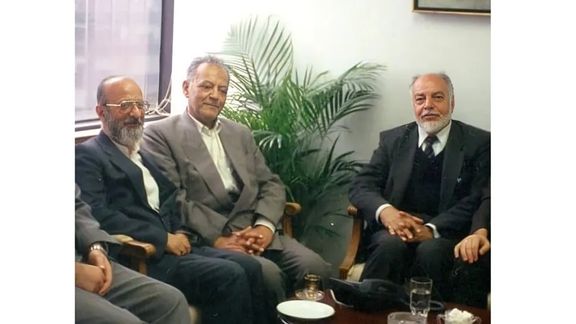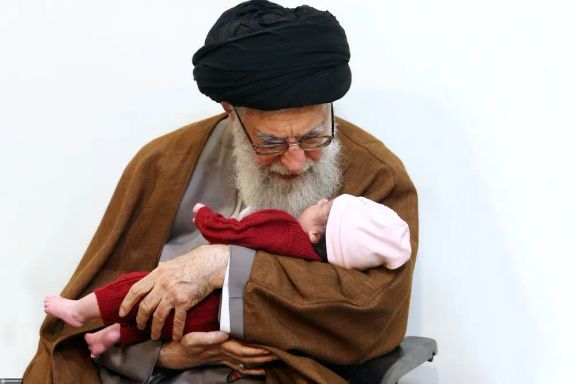Iran unveils plan to cut Afghan immigrant population by 10% per year

Iran's Parliament has proposed reducing the foreign national population by 10 percent annually, amid growing public controversy over the increasing Afghan influx.

Iran's Parliament has proposed reducing the foreign national population by 10 percent annually, amid growing public controversy over the increasing Afghan influx.
Although the proposal does not explicitly mention any nationality, the term ‘foreign national’ is widely used by Iranian officials and media to target Afghan migrants, who constitute a significant portion of the foreign population in Iran.
According to a report by state-affiliated ISNA on Tuesday, the plan outlines strict limitations on residence and employment for foreign nationals. The Ministry of Interior is tasked with ensuring that "the population of foreign nationals residing in the country decreases by 10 percent annually."
Additionally, if passed into law, within three months of its enforcement, authorities must ensure that foreign nationals and their families do not exceed "three percent" of the population in any city, village, county, or province.
As part of these efforts, border closures are being implemented and monitored with the help of artificial intelligence. Ahmad Ali Goudarzi, the commander of the Iranian Border Guard, announced that the closure of borders in key regions, including the southeast, northwest, west, and southwest, is advancing rapidly.
“The closure of the borders is being pursued swiftly and is progressing,” Goudarzi stated on Wednesday. He further explained that responsibilities like building border walls and roads have been assigned to the army and the IRGC, while tasks such as installing sensors, cameras, drones, and constructing watchtowers rest with the Border Guard.
The proposal comes amid growing concerns within Iran about the increasing number of Afghan migrants. Earlier this year, the Deputy Governor of Tehran warned about the "threatening" presence of undocumented Afghan immigrants, likening their removal to a "war” effort.
A recent report from the Tehran-based pro-reform newspaper Ham-Mihan revealed that Afghans must now purchase an expensive smart card to stay in Iran, a card that costs one billion rials (nearly $1,700), highlighting the Iranian authorities' intensified pressure on Afghan migrants.
Last year, the Supreme National Security Council banned Afghans from nearly half of Iran's provinces, further tightening immigration policies. Some reports suggest that as many as 10,000 Afghans have been entering Iran daily, with the Afghan population in the country approaching 10 million.
In addition to the growing influx, Iran's handling of Afghan migrants has raised humanitarian concerns. According to Afghan authorities, over 20,000 Afghan children were deported from Iran last year, many of them unaccompanied.
Iran's proposal to reduce the foreign population, particularly targeting Afghan migrants, reflects a stricter approach to immigration control under the new president, Masoud Pezeshkian.
The measures look set to intensify the difficulties faced by Afghan immigrants, raising concerns about the broader social and humanitarian implications for the population fleeing Taliban rule in war-torn Afghanistan.

Iran’s Ambassador to the UN, Amir-Saeid Iravani, has once again dismissed international claims about Tehran’s supporting Russia's war on Ukraine as “baseless and misleading.”
Rejecting a statement by the United States, the United Kingdom, and France, the move is consistent with Iran’s long-standing strategy of denying responsibility for its provision of drones used on civilian populations in Russia's war on Ukraine.
In a letter to the President of the Security Council and the UN Secretary General, Iravani attempted to redirect the blame, accusing the US and its allies of "fueling the flame of war" by providing Ukraine with advanced weapons.
Iravani specifically stated that the representatives of France and the UK had invoked United Nations Security Council Resolution 2231 (2015) to back their accusations against Iran.
He also accused the US of spreading similar false claims and of labeling Iran as a supporter of terrorism, asserting that such remarks are "misleading and baseless", in spite of Iran's support of terror proxies around the Middle East.
The denials ring hollow given the growing body of evidence that suggests Tehran has been actively supplying military hardware to Moscow, including Iranian-made drones.
The drones, including the Shahed-136 and 131 kamikaze models, have been deployed to attack civilian infrastructure and overwhelm Ukrainian air defenses, with hundreds of such drones being used since October 2022. Most recently, a large-scale assault involved around 100 Iranian Shahed drones.
Reports from late 2023 indicate that Tehran has also supplied ballistic missiles to Russia. Despite initially denying that it had supplied drones to Russia, the Iranian government later admitted to the transfers but claimed the equipment had been sent before Russia’s invasion of Ukraine.
Over the last 18 months, Iranian-backed plots across Europe have also been foiled as Tehran exports its terror beyond the Middle East to countries including the UK, Belgium, Greece and Sweden.
The head of the UK's MI5 intelligence agency also named Iran as one of the country's biggest domestic threats, while last year, the US named Iran as the world's number one state sponsor of terrorism.

Exactly one year ago, Iran International published an article featuring Middle East expert Yigal Carmon’s prediction that an Iranian regime-backed terrorist group would attack Israel in the fall of 2023.
The Iran International report titled “Will Iranian Proxies Target Israel In September Or October?” was the only open source news report prior to October 7 that defined a specific time period in which the Islamic Republic’s proxy Hamas would unleash its massacre in southern Israel.
A little over four weeks after publication of the Iran International article, the horrific violence of the US-designated terrorist movement Hamas produced mass rape, the murder of nearly 1,200 people and the abduction of over 250 people in southern Israel.
Iran International sat down with Carmon to revisit his article and hear his current thoughts about the Iranian regime-animated conflict that has engulfed the Middle East.
“It will not end as long as America stands by its enemies and not its allies,” Carmon said in his typically blunt fashion.
He continued, “The Obama administration sought to promote Iran’s role in the Muslim world. The policy has not really changed despite the fact that Iran’s proxies, Hezbollah, Iraqi militias, Houthis, in addition to Hamas and Palestinian Islamic Jihad, are actively fighting the United States.”

Carmon observed, “To add insult to injury, Qatari authorities have repeatedly stated they would not permit the US to launch any attack on Iran from the CENTCOM base at Al Udeid Air Base. This reflects the administration’s broader Middle East policy of distancing itself from its allies while appeasing its adversaries."
For Carmon, America’s allies in the region are the anti-Iran regime opposition within Iran, Bahrain, Saudi Arabia, the United Arab Emirates, Egypt, Jordan and Israel.
Carmon, who speaks fluent Arabic and served as the counter-terrorism advisor to two Israeli prime ministers, has long had a singularity of purpose about exposing the world’s worst state-sponsor of terrorism—the clerical regime in Iran—and its Islamist strategic partners, including the Sunni regime in Qatar.
In January, the The Wall Street Journal wrote about Carmon and his institution in an article titled “When Terrorists Talk, They Listen. Memri, the Middle East Media Research Institute, fights Hamas by telling the world what its leaders are saying.”
The roots of Carmon’s forecast about the Hamas-Iran-Qatar troika invasion of Israel can be found as early as 2018 in his essay titled Is Gaza In Need Of Qatar's Aid?
In it, he wrote regarding Qatar’s funding of Hamas “the destructive results of which are bound to come sooner or later.”

While many Mideast experts could not envision an alliance between a Sunni Islamist state like Qatar with the revolutionary Shi’ite regime in Tehran, Carmon laid out in plain terms that “Islamist ideology” serves as the common denominator for the rogue regimes across the region. Religious ideology matters greatly when it comes to what drives human and state behavior.
“Qatar is a supporter of the Muslim Brotherhood, Hamas and the Islamic Movement in Israel, and an ally of Turkey, which considers itself an enemy of Israel and which under President Erdoğan adheres to the Islamist ideology that seeks to annihilate it, as well as an ally of Iran,” he wrote in his 2018 essay.
Carmon said regarding the October 7 attack that “Iran provided the training, tactics and weapons. Everything that has to do with the actual attack.”
When asked about the reactions to his analysis before October 7, Carmon said, “Generally, it was not taken seriously. It was contrary to everything they heard from intelligence to the media, from research institutes and think tanks in Israel headed by former chiefs of intelligence.”
He said his article went “contrary to the NGOs, who visited Gaza and told them Gaza is like the Brazilian favelas or worse while in reality Gaza was a thriving Mediterranean city developing immensely.” MEMRI ran a series of articles with video footage in January and February this year that debunked the notion that Hamas-controlled Gaza was immersed in a “Suffocating occupation” and a “Humanitarian disaster” prior to October 7. Carmon noted that Gaza Strip contained “institutes of higher education, malls, towers, five-star hotels, luxury restaurants, water parks, hospitals, automobile dealers for luxury cars, zoos and a musical center.”
He stressed that his warning contrasted with the views of the Israel Defense Forces. “The military told everybody that they [Hamas] were deterred. So it was perceived as a political attack rather than a professional assessment based on evident material from open sources that everyone can see.”
When asked who listened to his analysis, he said the people in MEMRI and Iran International. Carmon said the strengths of his analysis “is taking open sources seriously. And here I have to say something very important. And the arguments against it were primarily racist. The argument goes as follows: Arabs just talk and are not to be taken seriously. Arabs are for sale. We are buying them. Arabs are fools. We can help them [in Gaza] to be a counter to the Palestinian Authority.”
Regarding the Hamas psyche, he said, “It is not hard for me to go into the heart of a killer.”
Carmon seems to have insight into human psychology—a sort of sixth sense—that he attributes to his understanding of empathy.
In short, he jumps into the heads of the Islamist enemies of the West.
He said the consensus racist argument also pooh-poohed Arab military capabilities: “They can’t operate mobilized units because they are primitive.”
Carmon said, “Now we know they attacked with 6,000 people [on October 7].”
“I took them seriously and I believe they mean it. I believe this group of extremists is not for sale. I believe they are not stupid. They have advanced capabilities. I could see it in the videos.”
Carmon asks: “Is it necessary to know Arabic? No. But it is always good to know languages” and, he stresses, “to have an open heart” about out-of-box thinking that goes against mainstream beliefs.
Jerry Coyne, Professor Emeritus at the Department of Ecology and Evolution, Committee on Evolutionary Biology at the University of Chicago, met with Carmon and this writer in September 2023. He would, in January 2024, blog about the meeting, Carmon’s prediction and the Iran International article.
Coyne issued his own early warning for the West in his piece: “If intelligence officials in the West aren’t reading MEMRI on a regular basis, they’re making a mistake. As you see, even the Biden administration has been gulled by the Middle East, and this happens pretty regularly. [Secretary of State] Antony Blinken is an especially notable victim, and he passes his gullibility on to [President Joe] Biden.”

The eulogy reciter of Iran's Supreme Leader's office, Meysam Motiee, has traveled to Thailand in a bid to export the country's ideology abroad.
The trip, like many other initiatives by Iran’s clerical rulers, has stirred controversy and renewed criticism over the Islamic Republic’s efforts to expand its ideological influence abroad.
Motiee, seemingly a PhD holder and religious reciter, is celebrated by Khamenei as one of the system's "miracles," a symbol of how the revolution has penetrated the academic world, as Khamenei says. His close ties with the Supreme Leader's office have turned him into one of the most prominent figures used by the Islamic Republic to project its narrative, domestically and internationally.

While Iranian state-affiliated media tout Motiee's journey to Thailand as a cultural and religious mission, many see it as yet another example of the Islamic Republic’s broader strategy of exporting its ideology under the guise of religious outreach.
Iran has consistently dispatched thousands of missionaries and operatives to countries worldwide, in an ongoing effort to promote Shiism, and to bolster Tehran's political clout abroad.
Muslims are Thailand's largest minority, constituting around 12 percent of the 62.5 million population, though just one percent of them is Shia Muslim.
According to IranWire, Motiee rose to fame in 2017 when, during Eid al-Fitr prayers led by Khamenei in Tehran, he recited a poem sharply criticizing the nuclear deal and President Hassan Rouhani’s administration.
Despite backlash from Rouhani’s supporters, Khamenei himself publicly defended Motiee, further solidifying his status within the country's political system.
But Motiee’s influence extends far beyond Iran's borders. His eulogies have frequently aligned with Tehran’s political messaging, particularly in support of the "Axis of Resistance", the Tehran-backed network of militias and political groups across the Middle East. In his performances, he has repeatedly expressed opposition to Israel and Saudi Arabia, echoing the system’s aggressive foreign policy positions.
Under Khamenei's leadership, eulogists or "maddahs," who once earned their livelihood by performing lamentations for the deceased in graveyards or reciting tragic tales during Muharram, have now become key political figures in the Islamic Republic.
They hold significant influence in political circles and government offices, using their close ties to Khamenei to expedite various business matters, often for a fee.
During election seasons, eulogist associations engage in political propaganda on behalf of candidates, charging substantial sums. The closer a maddah is to Khamenei, the higher his fees and the greater his sway.
In 2005, a group of 100 maddahs endorsed Mahmoud Ahmadinejad for president.
Motiee’s trip to Thailand is far from unique. The Islamic Republic has long used religion as a tool to spread its influence globally. One of its most significant institutions in this endeavor is Al-Mustafa International University, a religious and educational center based in Qom.
Established under Khamenei’s orders in 2008, Al-Mustafa serves as an instrument in the ideological expansion. It operates in over 60 countries and receives significant funding from Iran’s budget, over $23 million in 2024 alone.
Despite claiming to be an academic institution, Al-Mustafa has been accused of serving as a base for the Quds Force, the overseas arm of the Islamic Revolutionary Guard Corps (IRGC).
With nearly 40,000 foreign students, many of whom hail from conflict-ridden regions like Afghanistan and Pakistan, the institution has played a key role in recruiting fighters for Tehran’s proxy wars.
The US government has sanctioned Al-Mustafa for its connections to Iran's military operations, yet it continues to operate globally, attracting students from over 130 countries, many of whom return home as loyal followers of Tehran’s ideological project.
In recent years, the Islamic Republic’s clerics, despite their anti-Western rhetoric, have shown a clear preference for international travel, often under the guise of religious outreach. Figures like Hamid Rasaee, a hardline cleric and MP close to the system, and the late cleric and Shia political theorist Taqi Mesbah Yazdi have made similar trips to Europe and even the United States.

The irony of these foreign trips is not lost on Iran’s beleaguered population. While the Islamic Republic continues to chant anti-Western slogans and promote isolationist policies, its officials travel freely, often to Western nations under the banner of promoting Shiism.
Meanwhile, the cost of these overseas missions is shouldered by the Iranian people, who have been hit dramatically by the country's economic crisis which has forced many below the poverty line.

Iran has intensified its efforts to interfere in the US election, targeting the campaigns and supporters of both candidates, in an attempt that seems to be coordinated with Russia and aimed at sowing internal discord, according to the US officials and cybersecurity experts.
In the last few weeks only, giant tech companies Google, Microsoft and Meta have all reported malign activities with connections to Iran, warning that Iranian efforts may become “extreme”, even inciting violence against political figures to create chaos and undermine the integrity of the upcoming elections.
“It seems that there’s coordination between Tehran and Moscow’s information operation,” Marcus Kolga, head of DisinfoWatch told Iran International. “The US and all western democracies need to be paying close attention and exposing them. The combined information and influence operations of Iran, Russia and China represent a serious threat to all western democracies - which we cannot afford to ignore.”
Up until a few years ago, Iran was no match for Russia and China in cyber attacks. But that seems to have changed according to recent US intelligence assessments that underlined Iran’s continued efforts to hack American individuals and organizations. "Iran is becoming increasingly bold in its attempts to stoke discord and erode trust in our democratic institutions," the US Director of National Intelligence said in July.
Iranian officials, however, have dismissed all such reports, calling them “unsubstantiated.”
The escalating cyber activities from Iran come at a critical time as the US prepares for the 2024 presidential election in November. Iranian operations seem to be directed mainly towards former president Donald Trump, fearing, perhaps, that he would take a tougher stance against the ruling elite in Tehran if elected president.
Earlier this year, Iranian operatives reportedly hacked the emails of Roger Stone, a longtime Trump adviser, and attempted to infiltrate the Harris campaigns. Last month, Meta (formerly Facebook) revealed it had detected similar efforts on its WhatsApp messaging platform targeting both political campaigns.

A New York Times report Wednesday named three websites that it claimed are linked to Iran’s disinformation efforts, posing as legitimate news outlets catering for Americans of varying political persuasion. According to the report, Savannah Time, NioThinker and Westland Sun target conservatives, progressives and Muslim communities respectively, publishing tailored content that aims to deepen divisions in the US.
The scope of Iran's activities extends beyond disinformation. In yet another recent report, Microsoft and Google warned about attempts to breach U.S. presidential campaigns in the lead-up to the November election.
Meta disclosed on 24 August that it had thwarted attempts by Iranian hackers to compromise the WhatsApp accounts of US officials connected to Joe Biden and Donald Trump. The hackers allegedly posed as technical support representatives from companies like Google and Microsoft to gain unauthorized access. Meta said it had quickly intervened, blocking the accounts before any significant breaches occurred.
As tensions between the two nations remain high, the possibility of foreign interference adds another layer of complexity to an already fraught political landscape.

New data highlights a persistent decline in Iran's marriage rates since 2011, exposing the ineffectiveness of the Supreme Leader’s prolonged efforts to boost population growth amid deteriorating economic conditions.
The latest findings from the state-run National Population Research Institute suggest that the average age of marriage for women has reached 24, while men are marrying at around 28 years old.
According to the head of the Institute, Mohammad-Javad Mahmoudi, the number of registered marriages in Iran has dropped dramatically since 2011,with almost half a million marriages registered – a fall from the peak of 891,627 marriages in 2010.
This downward trend has persisted despite repeated calls from Supreme Leader Ali Khamenei for policies to facilitate marriage and boost population growth.
The figures also suggest that the trend kickstarted the year international sanctions tightened their grip on the Iranian economy in 2011. At the end of that year, the US blocked oil importers from making payments through Iran's central bank and imposed measures that restricted Iran's access to foreign currencies. These sanctions were a response to Iran's defiance of international norms on nuclear weapons development, aiming to limit its nuclear proliferation potential and enforce global demands for transparency and accountability.
The figures also reveal that before the downward trend, there was a dramatic rise in the number of marriages in Iran with registrations soaring nearly ninefold from 152,411 to 891,627 between 1966 to 2010. This surge represents the highest recorded marriage rate in over fifty years.

Khamenei’s rhetoric on population growth has been matched by a series of laws and regulations designed to encourage young Iranians to marry and have children. However, these initiatives are being undermined by significant economic challenges, including the impacts of international sanctions that have made it increasingly difficult for many young Iranians to afford the costs of starting a family.
Iran observers often highlight that the country’s economic struggles are largely a consequence of sanctions imposed due to its support for regional terrorism and severe human rights abuses. The US and EU have targeted Iran for backing militant groups like Hezbollah and Hamas, as well as for its widespread suppression of political dissent and activism.
The decline in marriage rates also reflects a broader demographic shift in Iran. Over the past 57 years, the average age at which women first marry has risen by approximately five and a half years, while for men, it has increased by about three and a half years.
This delay in marriage, coupled with economic uncertainty, has also led to a decline in birth rates. In the first nine months of 2023, Iran experienced the lowest number of births in the past decade, intensifying worries about the country’s future population growth. Abortion rates have also been on the rise in recent years.
Mahmoudi also warned that the number of women of reproductive age will sharply decline after 2029. This is due to the government’s failure to capitalize on the peak reproductive years between 2010 and 2022. "We have not yet optimally utilized the 12-year period between 2010 and 2022, during which we had a peak in the number of women of reproductive age," Mahmoudi admitted.

These demographic challenges emerge as Khamenei has once again instructed government officials to eliminate barriers to population growth. On September 3, Health Minister Mohammad-Reza Zafarghandi announced that discussions had been held on population growth policies and that experts were tasked with addressing these issues.
The Rejuvenation of the Population and Protection of the Family (RPPF) law, enacted by the Iranian Parliament in 2021 under Khamenei’s directive, has yet to produce significant results. While the law imposes penalties for actions against childbearing and marriage, economic pressures on young Iranians continue to outweigh these measures.
In a recent effort to tackle the population decline, the Central Bank of Iran announced on September 1 that it will allocate 500 trillion rials (over $830 million) from bank deposits for marriage and childbearing loans. An investigation by Iran International, however, revealed that this funding will fall short of meeting the actual demand for these loans.
This underscores the inadequacy of the government's measures and its failure to address the crisis effectively. Despite the large financial commitment, the government's approach is criticized for not sufficiently addressing the needs of young Iranians and failing to mitigate the broader economic pressures contributing to the decline in marriage rates and birth rates.
Iran's population growth rate has thus sharply declined to 0.6 percent, down from 1.23% just two years ago and a significant drop from the 4.21% rate seen in 1984.
Despite this, the Supreme Leader appears bent on boosting the population to 150 million by 2050. The relentless pursuit of demographic growth, frequently at the expense of individual rights and well-being, according to many observers, highlights the Islamic Republic’s disregard for the health and rights of its citizens, especially women and children, in favor of ideological ambitions.